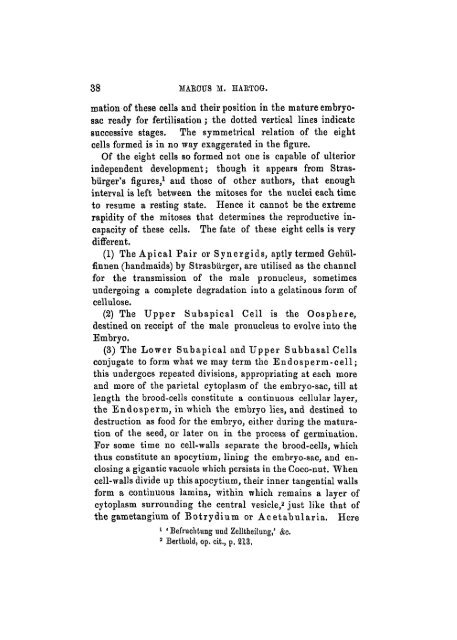Some Problems of Reproduction: a Comparative Study of ...
Some Problems of Reproduction: a Comparative Study of ...
Some Problems of Reproduction: a Comparative Study of ...
You also want an ePaper? Increase the reach of your titles
YUMPU automatically turns print PDFs into web optimized ePapers that Google loves.
38 MAROUS M. HARTOG.<br />
mation <strong>of</strong> these cells and their position in the mature embryosac<br />
ready for fertilisation ; the dotted vertical lines indicate<br />
successive stages. The symmetrical relation <strong>of</strong> the eight<br />
cells formed is in no way exaggerated in the figure.<br />
Of the eight cells so formed not one is capable <strong>of</strong> ulterior<br />
independent development; though it appears from Strasburger's<br />
figures, 1 and those <strong>of</strong> other authors, that enough<br />
interval is left between the mitoses for the nuclei each time<br />
to resume a resting state. Hence it cannot be the extreme<br />
rapidity <strong>of</strong> the mitoses that determines the reproductive incapacity<br />
<strong>of</strong> these cells. The fate <strong>of</strong> these eight cells is very<br />
different.<br />
(1) The Apical Pair or Synergids, aptly termed Gehiilfinnen<br />
(handmaids) by Strasbiirger, are utilised as the channel<br />
for the transmission <strong>of</strong> the male pronucleus, sometimes<br />
undergoing a complete degradation into a gelatinous form <strong>of</strong><br />
cellulose.<br />
(2) The Upper Subapical Cell is the Oosphere,<br />
destined on receipt <strong>of</strong> the male pronucleus to evolve into the<br />
Embryo.<br />
(3) The Lower Subapical and Upper Subbasal Cells<br />
conjugate to form what we may term the Endosperm-cell;<br />
this undergoes repeated divisions, appropriating at each more<br />
and more <strong>of</strong> the parietal cytoplasm <strong>of</strong> the embryo-sac, till at<br />
length the brood-cells constitute a continuous cellular layer,<br />
the Endosperm, in which the embryo lies, and destined to<br />
destruction as food for the embryo, either during the maturation<br />
<strong>of</strong> the seed, or later on in the process <strong>of</strong> germination.<br />
For some time no cell-walls separate the brood-cells, which<br />
thus constitute an apocytium, lining the embryo-sac, and enclosing<br />
a gigantic vacuole which persists in the Coco-nut. When<br />
cell-walls divide up this apocytium, their inner tangential walls<br />
form a continuous lamina, within which remains a layer <strong>of</strong><br />
cytoplasm surrounding the central vesicle, 2 just like that <strong>of</strong><br />
the gametangium <strong>of</strong> Botrydium or Acetabularia. Here<br />
1 ' Befruchtung nnd Zelltheilung, 1 &o.<br />
s Bertkold, op. cit., p. 213,

















